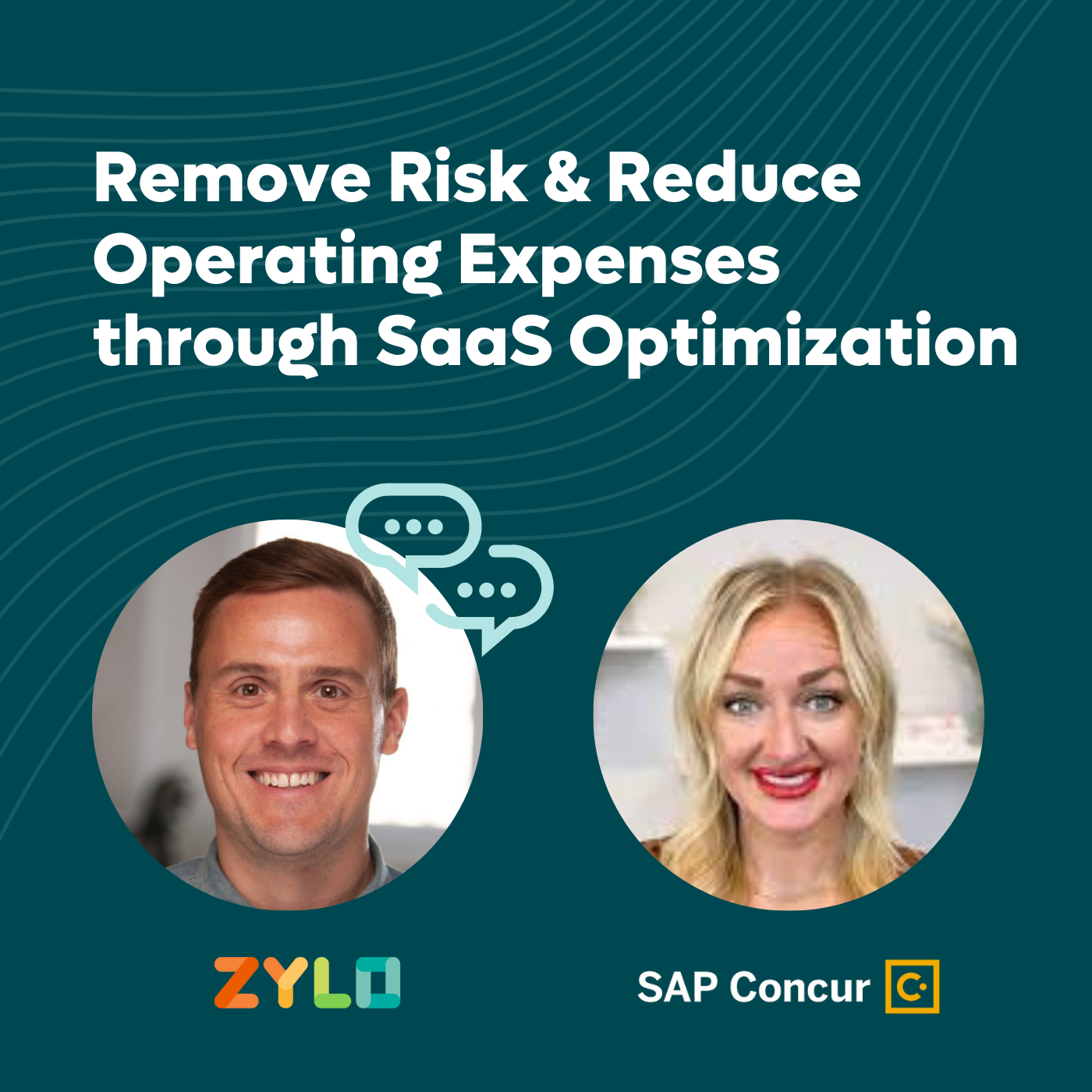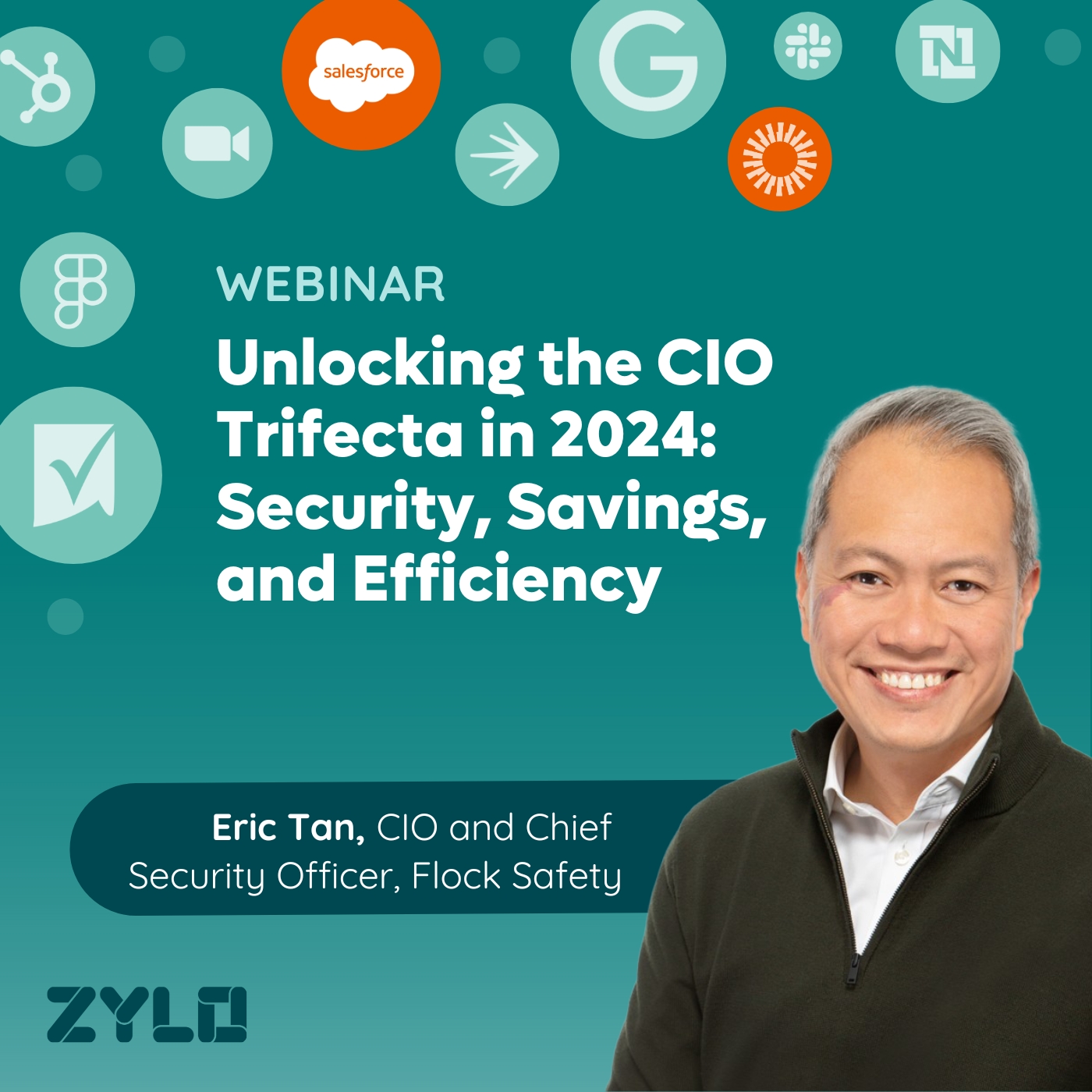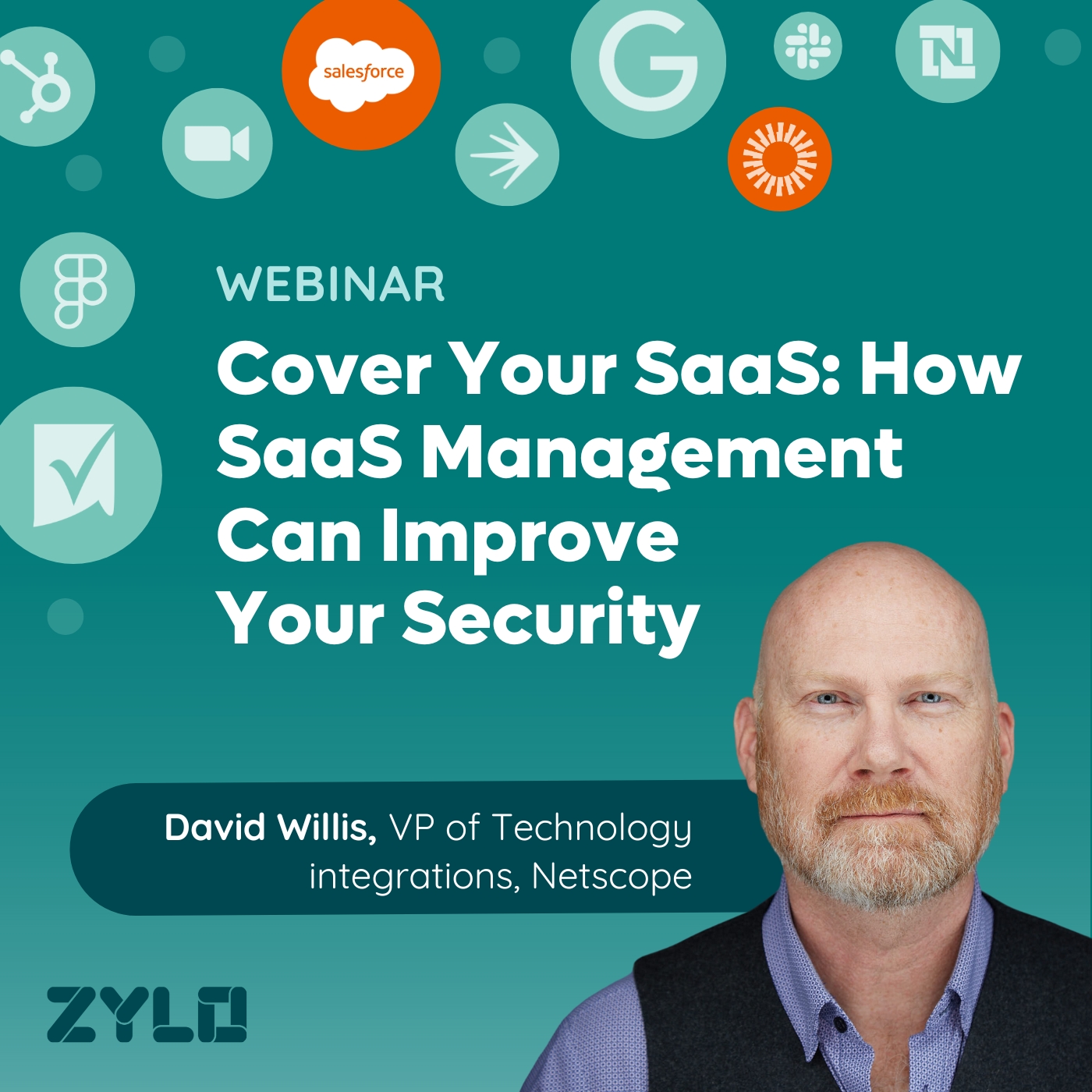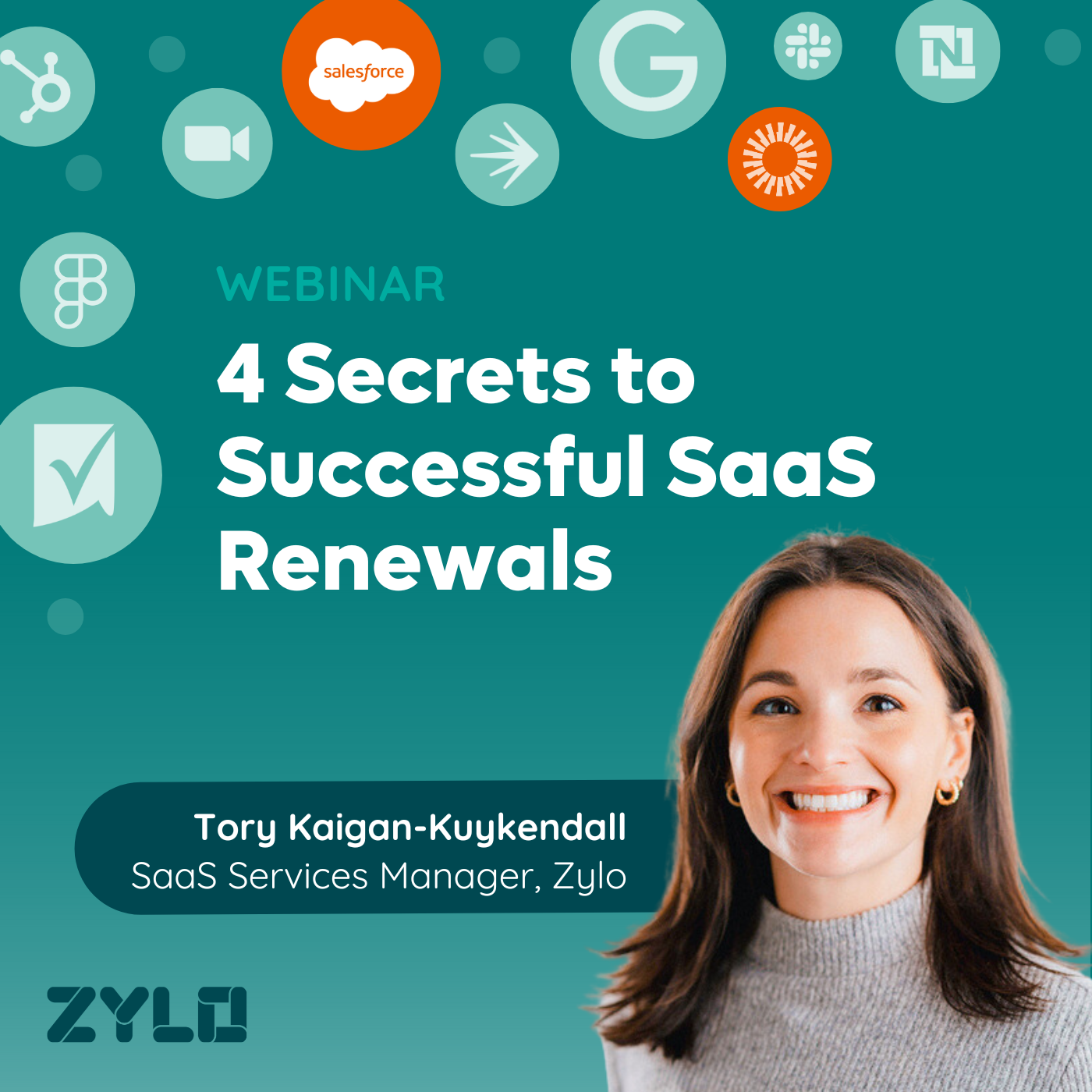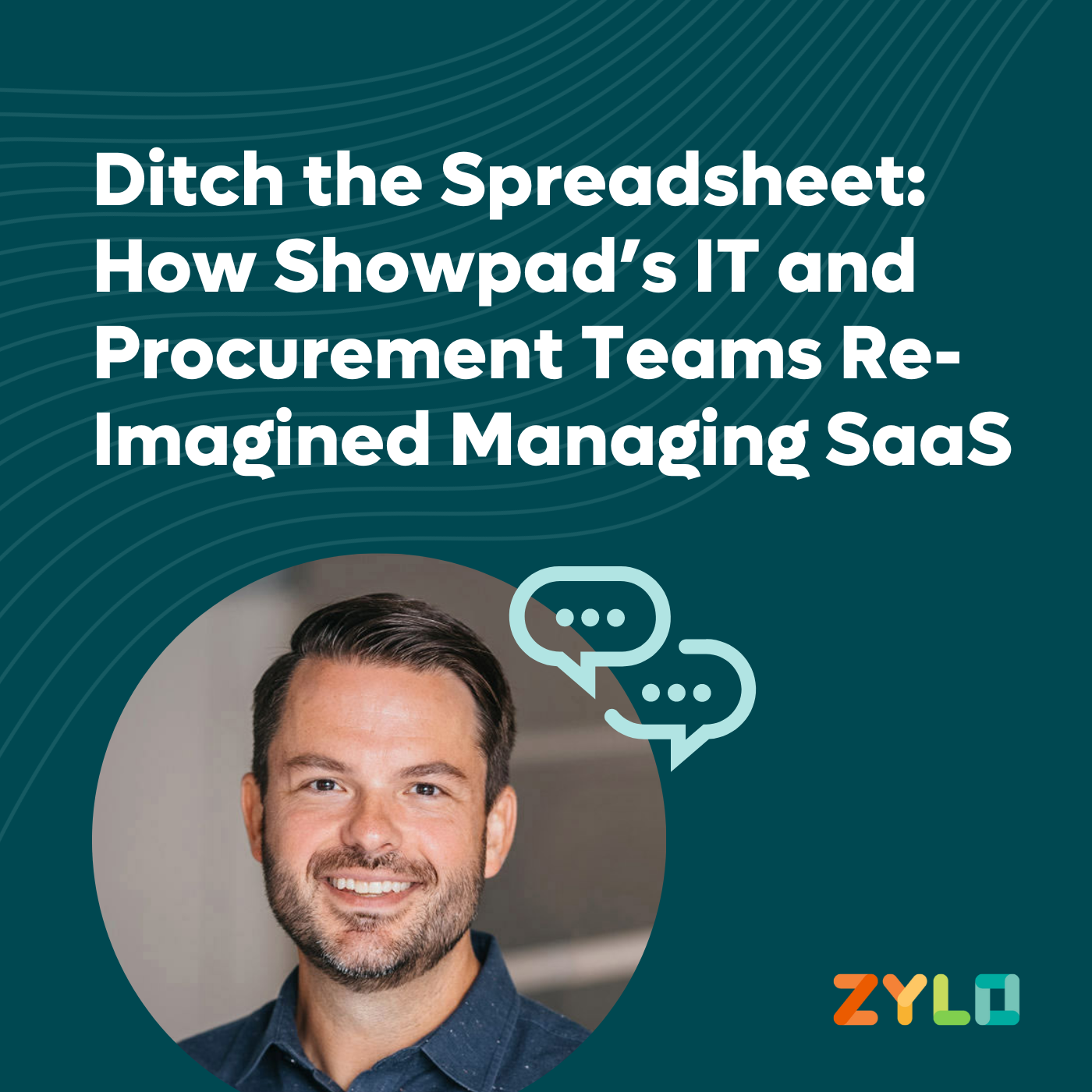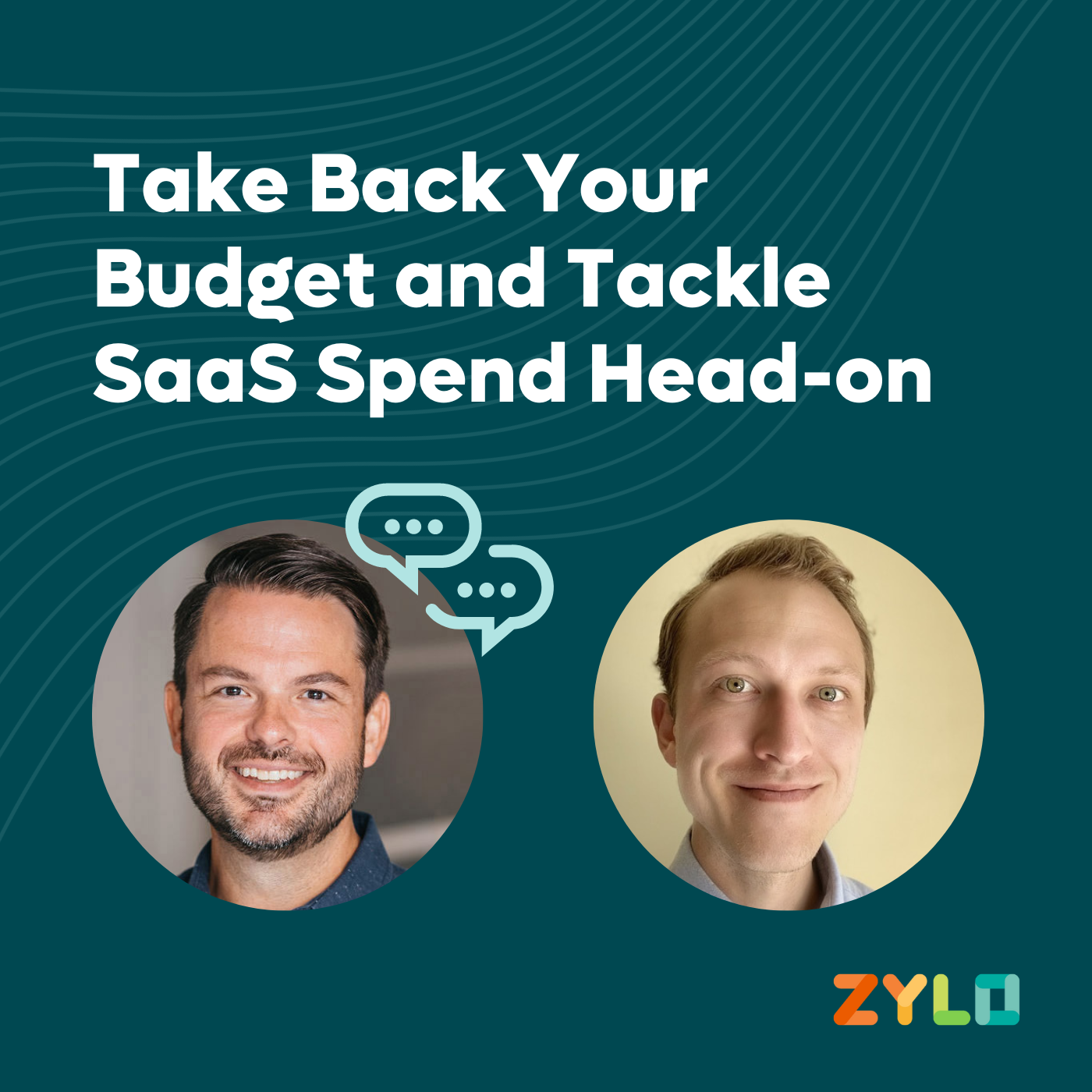Remove Risk and Reduce Operating Expenses (OpEx) through SaaS Optimization
- 0.5
- 1
- 1.25
- 1.5
- 1.75
- 2
Kelsey: Everyone is able to jump on this morning or afternoon. We are really excited to have this joint webinar on behalf of SAP Concur and Zylo, our endorsed staff partner. So thank you for joining and we'll go ahead and kick it off. We just got about 30 minutes here today. But Ben, I'll let you introduce yourself first.
Ben: Yeah, for sure. Thanks Kelsey. Super excited to be here with SAP Concur to jointly present on a topic that I love to talk about. It's all around helping organizations remove risk and reduce costs and operating expenses through an avenue that you may not be looking at yet. And that's all around SAS and software. So we'll dig in further, but my name is Ben. I'm from Zylo, one of the co- founders here at the company. I'm responsible for our strategy at the business, so I get the pleasure of working with Concur quite a bit as part of our endorsed staff partnership.
Kelsey: Awesome, thank you. And I'm Kelsey Hoover. I'm part of the SAP Concur team and I'm a senior director overseeing our America's regions. We're excited to have a lot of our clients on the call today and set this up. So we'll go ahead and go into the next. So why we have partners, so just on behalf of Concur and the team, wanted to kick this off a little bit of why you've probably received this invitation from your Concur team. SAP Concur has hundreds of partners and a really robust partner ecosystem that we're really proud of because our partners have deep expertise and a lot of knowledge in specific industry or specialization fields. And we partner with these companies to extend the value of the Concur platform and to see more ways that you can benefit by using the tools and just some amazing partners out there, Zylo being one that we're really excited to showcase today. And a new term on the next slide that you'll see us kind of show as the Zylo partnership is one of our endorse apps partners. So many on the call might be familiar with our app center where we have many different partners that have APIs and connections into the Concur platform that can help give you integration to deepen the value that you can get through the tools and endorsed apps are special partners to us that have really been elevated as premier partners that have a really high amount of success with Concur clients. They're rapidly growing categories or specializations and they're ones that we've seen a lot of clients adopt and get a lot of value from. And so when we see real needs being met by our clients in ways that it's benefiting using the Concur solution, we are now moving those partners into an endorse app partnership to really showcase them to our clients as being something special that they could really benefit from. So we're very excited to say that Zylo is one of our select endorsed apps partners in the app center. And then next I'd just like to touch on kind of why Concur ended this invitation. So when the SAP Concur team is meeting with clients and having discussions, we're really looking at these five key business outcomes as ways that we can deliver value or bring solutions to you, insights, trends, ways that we can really help our clients. And so we look at different categories around how we can help you with productivity, with scaling the solution and when you're in kind of seasons of growth. But some really important ones that we're going to kind of talk about today are visibility into what's happening in the business, visibility into spend that we see with the Concur platform as well as controlling spend and looking at way for cost savings or to maximize compliance and risk and things like that. So we're really excited to bring on Zylo and talk about this need for our clients because we've seen a lot of clients come to us and say, I want to take the knowledge I have within Concur expense and figure out what are ways that I could really control spend more in different avenues or buckets or categories within the spend flowing through Concur expense. And this being one of them, SaaS, Shadow IT, it's a really big need of our clients. And so we're really excited to let Zylo kind of share how they're helping a lot of our customers with that. So with that, I'll turn it over to Ben. We'll pick his brain to hear from Zylo.
Ben: Awesome. Thank you, Kelsey. And as I said, can't be more excited to be partnering with SAP Concur and as an doorstep we really feel like we provide a lot of value to our shared customers. So I'm excited to talk more about that today. And one thing I wanted to key up as well is if you have any questions, please feel free to post them in the Q&A and we will definitely, I'll try to answer them throughout the presentation. Definitely we'll try to leave some time at the end to answer those questions and then if there's anything we need to follow up on, we'll do that as well. So to sort of set the stage, I thought it was helpful to sort of reflect back a little bit and think about what the sort of last 12 months have been like. And for a lot of people, a lot of organizations, it really has not been an easy 12 months. Using some of the headlines here that we've seen come across from lots of different types of companies, lots of different sizes of companies, there's been a lot of reductions that we've seen. I'm sure I know I have some close friends that were personally impacted. I'm sure a lot of you do as well. And really what we can take from this though is that the directive that we're hearing from a lot of enterprises is the time is now to reduce operating expenses and reductions is one way to do it. But we're here to talk about other ways that that can happen and other tactics that companies can take that can be really, really impactful and maybe help your organization out. So to dig in there a little bit further, I'm going to look at some spend numbers. So these figures come from Gartner. Gartner puts out a quarterly spend forecast. This one just came out in April, so a couple weeks ago, in April 20th, 2023. And I think the thing that's pretty eye- opening to me is you look at 2022 and 2023 and what Gartner is projecting from an IT spend perspective, growth perspective, they're projecting growth rates of 5.5%, hitting global spend about$ 4. 64 trillion from an IT perspective. So really when you think about spending, organizations are still investing into transformation exercises and they're investing a lot in those areas in order to make those things happen. Now I think if you then look at the different categories that Gartner is tracking here, the thing that stands out to me is software. So software is projected to grow over 12% from a spend perspective from 2022 to 2023 up to about$ 891 billion. So a lot of money's being spent on software. Again, speaking to some of the digital transformation efforts that are going on in business in businesses today, the sort of overall macroeconomic climate is not causing those things to slow down. Now if we double click again into software, Gartner also provides guidance that in 2022, or I'm sorry through from their market guide, the SaaS management market guide that put out in December of 2022, that through 2026 SaaS spend is going to be growing annually 15% to 20%. So not only is software growing faster than any other spend category that Gartner's tracking here, SaaS is growing even faster as a sub segment within that individual category. If we look at another analyst perspective from Forrester, Forrester is saying that by 2027, software will grow to 42% of total tech spend. And you saw the numbers earlier and we're talking about trillions of dollars here. It's a lot of money that's going to be being spent on software. And one other analyst perspective here is from IDC. So the reason why we see some of those differences with the 12% software growth, 15% to 20% SaaS growth is that IDC is saying for in 2022, sorry, my slide's loading here. And 2022 was the first time that they witnessed that cloud software overtook on- premise software from a spend perspective. By 2023, they're saying that two thirds of global spend for software will be on cloud software versus on- premise software. So that's really where we're seeing that high growth number specifically around SaaS and really where we see as a good opportunity for every organization to start to get their arms around it, put controls in place, the policies in place, to be able to reign in those ever growing costs. So a couple other stats here, these are from us at Zylo. Every year we put out a what we call the SaaS management index. It's an annual report that we produce that's looking at holistically SaaS data that's coming into the Zylo's platform. First thing of note here is that we found that oftentimes lots of organizations software is the second largest operating expense, second only to people. That's always not always the case, but we're usually seeing what in the top two or three, the software line item is a huge operating expense and again, a growing one for most every organization out there. We also find that on average organizations are spending about$ 50 million annually on software today in '22 and 2023. That grows quite a bit when you get into the large enterprise, but on average we're seeing about$ 50 million annual on SaaS applications. Next is that 44% of all software license are being wasted within a given 30 day period. So again, going back to the growth numbers, seeing a whole lot of spend going towards software, organizations are spending a lot of money on it and it's a growing area, but there's a lot of waste going on as well. There's a lot of tools that are being purchased that aren't being used. There's a lot of licensing out there that gets provisioned to end users that think they need a product, but then 60 days later they don't actually need it and they're sitting there wasting that license. And then lastly, with a lot of the data that how we partner with Concur, we're able to uncover what Kelsey called Shadow IT. So Shadow IT is really those IT purchases specifically software that are being bought by end users being bought by employees and then being reimbursed through your employees system. We see that about 37% of apps in the average customer's overall portfolio of software are being purchased by employees. So again, another area where there's likely a lot of cost savings but probably even more likely a lot of risk potentially being introduced to your business from when employees are out buying stuff that's not going through the proper purchasing channels, the right review process, and they're potentially putting company confidential or company private data into a public SaaS product that may not be in compliance with the controls that you have within your business. So last opportunity here for organizations to do things, but what really happens if you don't do anything about this, if you think, hey, we're probably okay, don't really need to dig into this, I'm going to refer back to our friends over at Gartner again. This is from that same SaaS management platform guide that I talked about that came out in December of last year, December, 2022. They're saying if you don't do anything, by 2027, organizations that do not get their arms around this are going to be five times more susceptible to a cyber incident or data loss. You don't know what you don't know, you don't know what's out there, you're not aware of the potential risks that could come to your business resulting in a lot higher risk profile for your company. The second thing is around spend. So organizations that don't get their arms around this through 2027, they're going to be overspending on SaaS by at least 25%. And if you go back to those numbers, $ 50 million on average it's growing 15% to 20% a year. We're talking some big dollars here where organizations are overspending on SaaS applications. So all that to say, we feel that this is a huge opportunity for all of you on our webinar today to start to get your arms around this and what we say at Zylo is it's time to get your SaaS in gear. So let's do that. Let's talk about how that can happen. The value you can expect to see from a SaaS management platform and really how you should think about that within your own organization. What we have seen, what we saw and what we all experienced over the last three or four years is that there was a mindset of growth at all costs. So as organizations accelerated through a digital transformation process, as we're all forced to go work from home and have a hybrid approach to getting work done, organizations really, really quickly move to enabling that type of work environment for their employees, buying a lot of software to enable growth as fast as possible. Now what we're seeing as a result of that is that people are realizing eyes are opened up, realizing how much they're spending on all the software, and again, the risk that's being introduced into their business and thinking about we need to have responsible growth. We still need to grow, but we need to do it responsibly. So we really think of the now time as the era of responsible growth and software is as right in the cross hairs of here, being able to deliver on this specific area of responsible growth. But question is how do you really do that? How do you do that effectively as possible? SaaS is a challenge, a challenge for lots of different reasons, but one of the biggest things that make it a challenge is that SaaS within organizations typically isn't owned by one group. So within teams you're going to find IT is oftentimes at the center. You think software, you think back 10, 15 years ago, IT was buying 100% of the software that's being used within a company. Today we find they only buy about or are responsible for about 18% of the software that's used within an organization. So lots of different parties are involved here from your finance and accounting teams to your procurement organizations that are responsible for going out and finding the right tools that need to deliver on the value that you need to provide back to the business that employees need, making sure you're getting the right price, staying on top of the renewal processes. You have large organizations that have software asset management teams and IT asset management teams wanting to understand what your license position looks like, how those tools are being used to make sure that you're using them responsibly. You have line of business folks that are out there finding the right tools that they need for their groups in order to enable them to be as productive as possible and meet the objectives that those parts of the business have. And then you have enterprise architecture teams that are trying to make sense of all the different tools you have and mapping them all together to make sure the data's flowing correctly in order to streamline the process for all your end users. And then you have employees, employees out there wanting to use the best tools possible, the tools that they prefer in order again to get their jobs done and get their goals and objectives for their company. So it makes it a big challenge when you think about all these people involved. When you think about how software is purchased today, when you think about the fact that anyone can really buy software, when you think about all the process that things go through from a purchasing perspective, when you think about employee expense and all the different ways that employees can reimburse stuff through through SAP Concur and then show what those tools are and it makes for a very confusing world to get your arms around us and get a system in place to do it. So that's really where Zylo comes into play. We're here to help deliver on that. And so I'll give you a quick high level overview of what we do and some of the great outcomes that we've been able to achieve with some of our customers. So when we think about Zylo and we think about SaaS management, there's really four key areas, four key pillars of value that we deliver on. Number one is continual centralized SaaS discovery. So what does that mean? That means we come in, we take a follow the money approach. So we look at all of the spend that's going on across your business, coming in from Concur, from an employee's expensing stuff, coming in from your ERP system and we have an AI based model that sits on top of all that data, understands what's being purchased. We normalize all that information and we bring it in a centralized system of record for you to then be able to know what's going on and know what tools you're purchasing and what you're buying. A really good example of this is a large financial services firm. They came to Zylo. We always ask when we start to work with a new customer, how many apps do you think you have? How much do you think you're spending? They came to us and they said, " Hey, we've got$ 100 million dollars in SaaS spend." And so we said, " Okay, that sounds significant. That sounds like a lot. We can definitely help you here." We came in, we ran our discovery process, so we hooked into their financial systems, our AI model did its work and result of that we found$ 300 million in SaaS. So there was a gap of$ 200 million that they didn't even know existed. So you can imagine they moved pretty quickly to get their arms around where what is that gap in knowledge? What are these tools that are out there? And to put some programs in place to reign in some of those costs. Next is license optimization. I mentioned 44% of SaaS licenses go wasted. That's a very true thing. We see that in our customers data all the time. With license optimization, we look into different systems within your organization, things like your single sign- on provider. We also have a whole catalog of direct integrations where we look into, SaaS applications themselves and we pull down user licensing and usage data in order to provide you with a centralized system where you can see every single app, who has access, what license do they hold and how are they using that tool. We then layer on insights on top of that in order to let you know when you have the opportunity to go take an action. And that action will be either be to downgrade a user to a different license type or to pull them back and remove access altogether from that system. Essentially pull them back and removing and saving, avoiding having to spend more or downgrading to different license tax within as part of your renewal process. So a good example of this one is we got a large telco company, they're based in Australia. They're very large. They had 16 different Salesforce orgs. They had struggled to try to get reporting in place to track, okay, who has access to which org, what license type do they have, how are they using that license? And with Zylo they were to come into a single Zylo account, connect all those different Salesforce orgs into a single environment, pulled back all the data, provided centralized visibility to know what's going on across all those different orgs. And they were able to deprovision thousands of licenses across those Salesforce orgs and have attributed over$ 4 million in savings to being able to do that within that platform. Third is cost savings and avoidance. I've sort of talked about cost savings quite a bit. That's a big driver here for lots of organizations for putting a SaaS management system in place. But we really see cost savings and cost avoidance sort of come together at the renewal time. And within our products we help with operationalizing the renewal process. So making sure you're staying on top of those renewals, making sure you're informed about those renewals before they hit you so you're not stuck in some sort of auto renewal situation or not agreeing to off- the- shelf terms or just off the wrap pricing. We're making sure that you're aware of what's going on, you have the data you need in order to properly negotiate and stay on top of those renewals in a proactive manner. A good example of this is that about a midsize CBG company that works with us. They came in, we were in discovery for them, as part of our discovery, we're going to tell you, Hey, here's all the apps that you have that do similar things. Right. Where you have redundant capability or redundant functionality across your full application stack. They came in, we ran that exercise with them and then we aligned to a renewal schedule for applications that they wanted to retire or get rid of due to redundancy in their overall capability stack for their organization. As a result of that, they've attributed about$2.5 million dollars in savings to putting the SaaS management program in place for their organization. And then lastly here is SaaS governance and risk mitigation. This one I love because governance is a fun thing to talk about and obviously risk is a huge factor for lots of organizations. But you think about what we're doing here, we're helping organizations get visibility, we're helping put reporting in place. So you know if controls that you're setting for your organization aren't being followed around, maybe software purchasing policies. If you've got a policy that says, Hey, no employee can buy software at all, no employees should be purchasing things and pushing software through a Concur. We're going to be able to surface that up and let you know if that's actually happening or not. Other things we help out with would be risk monitoring and control monitoring. So if you want to make sure every application you use is maybe SOC2 certified or complies with GDPR policies, things along those lines, we'll help provide that information as well within our application. And the last thing that sort of falls into this bucket is around what we call our application catalog. What this does allows organizations to take the centralized for record that we have, identify which apps they want to make available to their end users, and then publish out a catalog of those applications, almost like an internal app store where people can go search for apps, find an app and that they may want to use, or maybe they're searching for a specific app and we tell them, Hey, we don't have this app but here's the app you can get access to and then quickly and easily connect them to the right people to get access to those applications. So we call that freedom within a framework here at Zylo to give your employees the ability to go and find the apps they want, but also put some controls in our framework in place to make sure it's apps that have been sort of blessed by the organization. So a good example of this one, this is a hybrid tech company. They came to us. They wanted to really get their arms around what they own and what applications they had within their business. They did went through the discovery process. Again, we asked how many apps do you think you had? They said 70 applications. And we said, okay, great. Did our discovery work. We actually found 223 apps during discovery and it's sort of the most amazing thing about that, Kelsey, I saw you shaking your head there, is that 118 of those applications were actually coming through employee expense. So that was a really big Shadow IT issue and a lot of risk involved there with that many applications that really they just didn't have purview view to, didn't have visibility to, in order to understand that was really important for them. So that's sort of quick high level. You can sort of see you brought in staring at this little GIF here that's going in the middle. That's sort of a quick overview of the screens and capabilities within the products, but a lot of good stuff and a lot of great value points that we provide and deliver to our customers. So how do Zylo and Concur come together? How does this all work together and why are each of us better with each other? Well, our platform seamlessly integrates into Concur. You can go directly through the app center, you're able to go in, connect your Zylo account to your Concur accounts and then start to pull down those employee expenses into the system. When we connect, we pull back a year's with of data. So right away you'll be able to see a year's worth of information. You'll able to see what software's been purchased. So it's not just looking for maybe the software category, we're looking across all expense categories. We find stuff all the time miscategorized inside of employee expense. It's a continual process. So we are constantly pulling new data from Concur. So again, you can stay on top of it, you can monitor what's going on. Back to the governance conversation, output controls the place and monitoring what's happening and be alerted when employees are buying software. It does go down to the individual employee level so you can see who bought it, can tie out to department, you can track at employee level, how much software is being bought by each individual employee. Gain insights. We talked a little bit about some of the insights that we have around redundant applications, redundant purchases. We see all the time the same app being bought by multiple places within an organization. And then lastly, really just creating a single system of truth. It's really, really challenging today to do that, create that single system of truth across all parties within your organization. So what is next here? So a couple of takeaways for y'all that I would urge you to take advantage of. Number one, if you're trying to decide if it's time to get your SaaS in gear, if you're trying to really get your head around is this a problem for us, is this something that we even want to tackle right now? First things first, you can reach out to your Concur client success executive, work with them. They can pull a quick spend analysis of your Concur accounts to see if employees are expensing software. So they'll be able to look at how many titles are being purchased through Concur, how many transactions are going against, that they can see that are for software. Just so you can sort of get your head around, is this a big problem for us? Is this something that we think is important for us to prioritize or not? So that should be a quick way, an easy thing that you can go do today or after this right after call. Second, if you're like, yep, I know this is a problem. Man, then you're really speaking to me right now. I think this is something that we need some help with quickly, we're ready to help you. So feel free to head over to zylo. com. You can schedule demo with our team directly off of our website and we'll get to work working with you to build out the business case and really put together a point of view on the impact that putting assessment in the program could have for your business. And then lastly, if you're like, Hey, this has been really interesting, we might have a problem, not really ready to dig in yet, but I'd really like to learn more about this. I invite all of you, we have our annual user industry events next month, SaaS Me. QR code up there. If you scan, that should take you to the registration page. Please feel free to register for that event. Join us. It's a virtual event. Two days. We'd love to have you. Lots of great content. You can see some of the speakers down there that already confirmed. More to come. But we'll be sharing a lot of industry related content. Customers will be sharing great stories about the value that they've received and the benefits they've got by putting a SaaS management program in place. So I will leave this up so y'all can register for SaaS Me and we have a couple questions that came in. So let me see here. So number one looks like, can you talk a little bit more about the most common challenges that organizations have with SaaS? So yeah, definitely. I think the number one thing is visibility. When I think about even your own personal life, if you can relate back to your own family and you think about how many subscriptions is my family buying, right? I was asking a question right now, you probably have a hard time answering that. You probably to think about why I should go ask my spouse or my partner and my kids are probably buying stuff. You can get to some sort of conclusion probably pretty quickly. With the business, it's way harder. So just trying to figure out, thousands of employees potentially, hundreds of employees, what are they purchasing, what's going on? What are our renewal dates for all this stuff? Where are our contracts? All that information. It becomes a really big challenge. So just getting, creating that centralized system of record is typically the first thing that a lot of organizations are really struggling with and maybe trying to do on spreadsheets, but it's a really hard thing to get through. Okay. Next question. Tell me little bit more about the size of organizations and the types of companies that get value from a SaaS management platform. So great question. We find that really every organization has a problem around SaaS. I mean, with how easy it is to purchase software and how easy it is to onboard and adopt new tools. It's a big challenge really for lots of different types of organizations. We work with companies, everything from a few hundred employees all the way up to some of the largest organizations in the world like Nike and Salesforce and Adobe and others. And so broad spectrum, the customers that are listed up there, the companies up there are all customers of Zylo as well. So really big range of organizations that we work with today. So I think we're about at time, Kelsey. I don't know if there's anything else you want to mention.
Kelsey: Perfect timing. Right on time.
Ben: Right on time.
Kelsey: And if anyone has any follow up questions, feel free to shoot them over, put them in the chat, we'll still get them and we can follow up with you after and get you any more information you want. But as Ben shared, these are great next steps, to register for SaaS Me and the Concur executives would love to share your account analysis and reporting with you. So thank you everyone for joining and thank you Ben and the Zylo team for sharing these great insights.
Ben: All right. Thanks so much.
Kelsey: All right. Have a great day y'all.
Ben: All right. See you later.
DESCRIPTION
Software as a Service (SaaS) is a top OpEx item for many organizations, yet most companies have no visibility to know what they have and what they are spending. Organizations need to centralize the data to gain a complete and ongoing system of record of their cloud-based software portfolio, allowing them to identify duplicative applications, wasted licenses, and opportunities to reduce overall operating expenses quickly.
On average, organizations have 291 SaaS applications and $50M in spend. Larger organizations have 600+ apps and $224M in spend. Much of this spend is going through SAP Concur; benchmarks indicate that 37% off all apps purchased are bought by employees. Can you say with confidence where your company sits?
Join Zylo Co-founder & Chief Business Development and Strategy Officer, Ben Pippenger and Kelsey Hoover from SAP Concur as they discuss how big this problem will become, get some tactical advice on how to build a business case for SaaS Management, and get inspired from some impactful success stories of organizations that have gotten back in the driver seat of managing their software.
Today's Guests

Ben Pippenger


